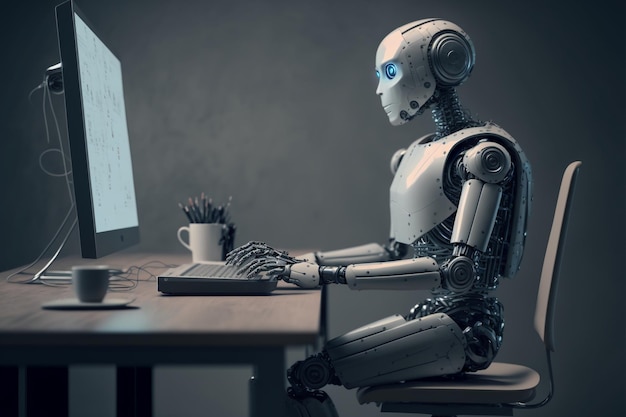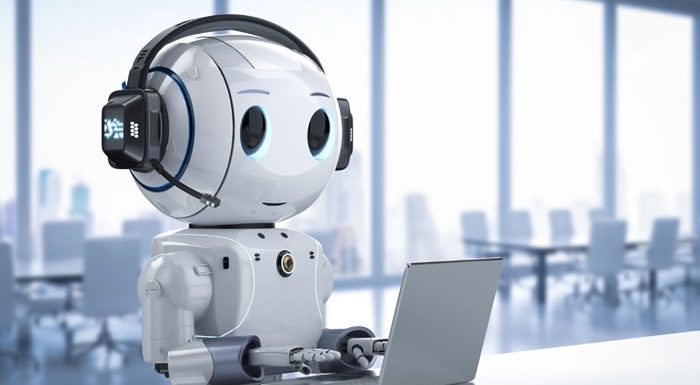A chatbot is not a robot; it is a software program designed to interact with humans. Chatbots are computer programs created to simulate human conversation and provide automated responses.
They can be found on websites and messaging platforms, offering assistance and answering questions. While chatbots may have a humanoid appearance in some cases, they do not have physical bodies or perform physical actions like robots. Instead, they rely on artificial intelligence and natural language processing algorithms to understand and respond to user input.
Chatbots have become increasingly popular in various industries, including customer service, marketing, and healthcare, as they provide a convenient and efficient way to handle repetitive tasks and engage with users.

Credit: www.freepik.com
Table of Contents
Who Invented Chatbots?
Chatbots, although often referred to as robots, are not technically robots. They are computer programs designed to interact with humans through text or voice. Invented in the 1960s, chatbots have a rich history that involves the contributions of several key figures.
One important figure in chatbot development is joseph weizenbaum, who created eliza, a natural language processing program, in the 1960s. Eliza simulated conversation by using pattern matching and scripted responses. Another notable individual is alan turing, whose concept of the turing test laid the foundation for evaluating a machine’s ability to exhibit intelligent behavior.
Over the years, chatbots have evolved, benefiting from advancements in artificial intelligence and machine learning. Today, chatbots can be found in various industries, helping businesses automate customer service, provide information, or offer entertainment. As technology continues to advance, chatbots are likely to become even more sophisticated, blurring the line between human interaction and automation.
Understanding Chatbots
Chatbots, known as virtual assistants, have become increasingly popular in recent years. These ai-powered programs have the ability to carry out conversations with users through text or voice. To understand what exactly a chatbot is, we need to look at its definition.
A chatbot is a computer program designed to simulate human conversation, providing responses to user inquiries based on predefined rules or ai algorithms. There are different types of chatbots, including rule-based bots and ai-powered bots that use natural language processing.
These chatbots can be deployed in various industries, serving as customer service representatives, personal assistants, or even entertainment companions. With advancements in technology, chatbots have become an integral part of many online platforms, providing quick and efficient assistance to users.
Their role in technology continues to expand, as they offer personalized experiences and streamline interactions between humans and machines.
Is The Chatbot A Robot?
Chatbots and robots may seem similar, but they have distinct differences. While robots typically have physical bodies and can perform physical tasks, chatbots are virtual assistants that engage in conversation with users. Unlike robots, chatbots don’t have a physical presence but operate through messaging apps or websites.
They use artificial intelligence and machine learning algorithms to understand and respond to user queries. Chatbots are designed to simulate human-like conversation and provide information, answer questions, or assist with tasks. They rely on natural language processing to interpret user inputs and generate appropriate responses.
Chatbots are becoming increasingly popular in various industries, including customer service, healthcare, and e-commerce. They offer a range of benefits, including 24/7 availability, improved customer experiences, and cost savings. So, while chatbots may not be robots in the traditional sense, they are modern digital assistants that effectively support human interactions.
Chatbot Technology
Chatbots and robots may seem similar, but they are not exactly the same. Chatbots are based on ai technology and use natural language processing (nlp) to understand and respond to user queries. Nlp enables chatbots to interpret and generate human-like responses.
Additionally, chatbots leverage machine learning algorithms to continuously improve their responses based on user interactions. This means that chatbots can learn from the data they receive and adapt their behavior accordingly. While chatbots can mimic human conversation, they lack physical presence and ability to perform physical tasks that robots possess.
So, while chatbots are part of the ai world and rely on technology similar to robots, they should not be confused with physical robotic devices.
Benefits Of Chatbots
Chatbots offer numerous advantages for businesses. They can improve customer service by providing instant responses to questions and concerns. The use of chatbots also results in time and cost savings for companies. Repetitive tasks can be automated, freeing up employees’ time to focus on more complex and value-added activities.
With chatbots, businesses can provide round-the-clock support and assistance to their customers, enhancing customer satisfaction and loyalty. Additionally, chatbots can handle multiple customer interactions simultaneously, ensuring prompt and efficient service. Overall, integrating chatbots into business operations can streamline processes, enhance customer experiences, and boost productivity.
Embracing this technology can lead to significant benefits for organizations across various industries.
Challenges Of Chatbots
Chatbots are often mistaken for robots, but there are certain challenges that come with chatbot technology. One of these challenges is the language and communication barriers that can arise. Chatbots may struggle to understand and respond effectively to different languages or dialects.
Another challenge is the privacy and security concerns that surround chatbots. As chatbots become more advanced and collect personal data, there is a heightened risk of hacking or misuse of this information. These limitations highlight the need for continuous improvement and fine-tuning of chatbot technology to address these challenges.
By overcoming these obstacles, chatbots can become even more efficient and effective in their roles.
Future Of Chatbots
Chatbots are an integral part of the future tech landscape, but are they really robots? Advancements in chatbot technology have made them more sophisticated and versatile. Integration with other technologies allows chatbots to provide personalized and efficient services. From customer support to e-commerce, their potential applications are vast.
Various industries, such as healthcare and finance, are utilizing chatbots to streamline processes and improve user experiences. With their 24/7 availability and ability to handle multiple conversations simultaneously, chatbots are proving to be invaluable tools. As the technology continues to evolve, chatbots will become even more intelligent and capable, making them an essential part of the digital landscape.
The future of chatbots is bright, and their impact on various industries is only expected to grow. So, while chatbots may not fit the traditional definition of a robot, they definitely have a significant role to play in shaping the future.
How Businesses Can Use Chatbots
Chatbots are an innovative technology used by businesses for various purposes. They assist in customer support and engagement by providing quick responses and solutions. Using chatbots in lead generation and conversion helps businesses capture valuable information and convert prospects into customers.
In the realm of e-commerce and sales, chatbots play a vital role in guiding customers throughout their purchase journey, suggesting products, and providing personalized recommendations. With their ability to understand and respond to customer queries, chatbots enhance customer experience by offering real-time assistance.
Additionally, they save time and resources for businesses by automating repetitive tasks and handling multiple inquiries simultaneously. As a result, chatbots streamline operations, increase efficiency, and improve overall customer satisfaction. Embracing this technology can bring immense advantages to businesses in today’s fast-paced digital era.
Ethical Considerations
Chatbots are often mistaken for robots due to their advanced capabilities in human-like communication. However, despite their similarities, there are ethical considerations surrounding their use. Privacy and data protection must be prioritized when implementing chatbots. Transparency and accountability are crucial to ensure users’ information is handled responsibly.
Additionally, unbiased responses from chatbots need to be guaranteed, avoiding any potential bias or discrimination. By addressing these ethical considerations, organizations can create a safer and more trustworthy environment for users engaging with chatbots. The ongoing development and proper implementation of ethical guidelines will facilitate a seamless integration of chatbots into various industries and improve the overall user experience.
Examples Of Chatbots
Chatbots are intelligent computer programs designed to simulate conversation with human users. They are not physical robots, but virtual assistants that can interact with people through messaging platforms. Examples of chatbots include popular platforms such as facebook messenger, whatsapp, and slack.
These chatbots are used in various real-world scenarios to automate customer service, provide personalized recommendations, and assist with product queries. Successful chatbot implementations can be seen across industries, from e-commerce to healthcare. They help businesses streamline processes, improve customer experience, and save time and resources.
While chatbots may not physically resemble robots, their capabilities make them valuable tools for businesses looking to enhance communication and engagement with their audience.
Frequently Asked Questions
What Is A Chatbot And How Does It Work?
A chatbot is an ai program that simulates human conversation through a chat interface. It uses natural language processing (nlp) to understand and respond to user queries. Chatbots can be rule-based or ai-powered, providing automated assistance and personalized communication.
Is A Chatbot The Same As A Robot?
Although a chatbot and a robot can both interact with users, they are not the same. A chatbot is a software application, while a robot is a physical device that can perform tasks in the physical world. Chatbots can be integrated into robots, but they can also exist independently on various platforms.
Can Chatbots Think And Learn On Their Own?
Chatbots can be programmed to learn and improve over time. They use machine learning algorithms to analyze user interactions and adapt their responses accordingly. While they can provide intelligent responses, chatbots do not possess consciousness or independent thinking abilities like humans do.
How Are Chatbots Used In Businesses?
Chatbots are widely used in businesses for various purposes. They can handle customer inquiries and support, provide personalized recommendations, assist in online shopping, automate tasks, and even perform transactions. By integrating chatbots, businesses can enhance customer experience, save time, and improve operational efficiency.
Are Chatbots Replacing Human Customer Service Representatives?
While chatbots can handle simple customer queries effectively, they are not intended to replace human customer service representatives entirely. Chatbots excel in providing quick responses and handling repetitive tasks, but they lack the empathy and nuanced understanding that humans can provide.
Human representatives are still crucial for complex or sensitive customer interactions.
How Secure Are Chatbots In Safeguarding User Information?
Chatbot developers prioritize security and data protection. They adhere to strict privacy policies and implement encryption protocols to ensure user information remains confidential. However, it is essential for users to be cautious and avoid sharing sensitive personal information through chatbots, just as they would in any online interaction.
Conclusion
To sum up, chatbots play a crucial role in enhancing customer experience, automating tasks, and streamlining processes. While they are often referred to as robots, it is important to note that not all chatbots are physical entities with mechanical bodies.
Instead, they are software programs designed to interact with users in a conversational manner. As technology continues to evolve, chatbots are becoming more intelligent and capable, leveraging natural language processing and machine learning algorithms to provide more personalized and accurate responses.
These virtual assistants can handle a wide range of tasks, from answering simple queries to assisting with complex transactions. With their 24/7 availability and efficiency, chatbots have proven to be valuable assets for businesses, saving costs and improving customer satisfaction.
As users become more accustomed to interacting with chatbots, their adoption will likely continue to rise, transforming the way we communicate and engage with technology. Embracing chatbots can position businesses at the forefront of innovation, delivering seamless experiences and staying competitive in a rapidly evolving digital landscape.

Leave a Reply